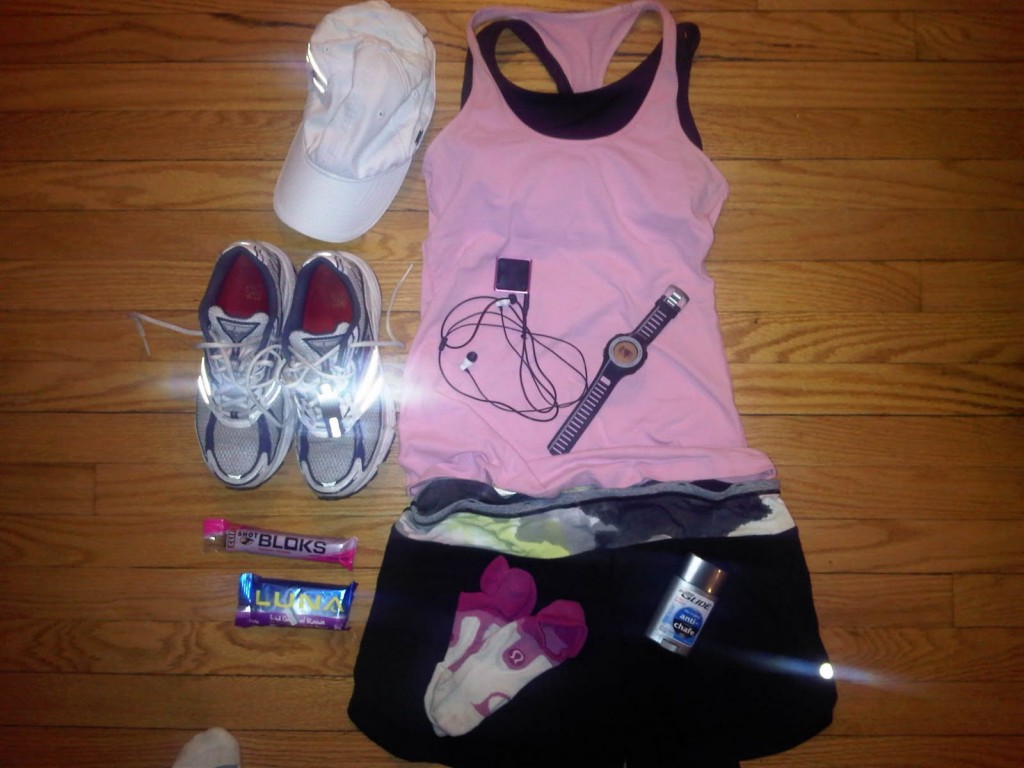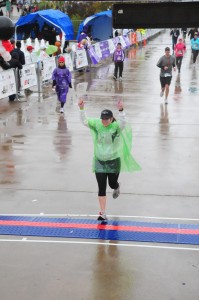Happy Wednesday!! This week’s Marathons +Moderation post comes from a BRAND new marathoner!! This rockstar pushed through her first marathon just this month and therefore I was thrilled when she was willing to share her thoughts. I hope you all enjoy her post as much as I did!
Hello, readers! My name is Kristin from Sassphalt Runner (@SassphaltRunner on Twitter) where I blog about my running experiences with a specific focus on believing in yourself. I’m excited to be participating in the “Marathons & Moderation” series as a newbie marathoner. Thank you for contacting me, Ashley!
First, let me start with a brief, somewhat sporadic running history for you. I ran in college for exercise and it wasn’t until 2005, well after I graduated, that I started entering local 5Ks. I was completely content with the occasional race and I left it at that.
My running came to somewhat of an abrupt stop around late 2007-2008 when I became increasingly exhausted. In 2008 after a visit to my doctor I was diagnosed with thyroid disease. Correcting my abnormally low thyroid levels was key to me getting back on track (no pun intended). Always listen to your body, friends!
This was an eye opener for me. Now that I was getting back to normal I started to believe in my capability again. In 2010, I made a pact with myself to run my first half marathon. I trained alone through a brutally warm summer. I educated myself on the do’s and don’ts of long distance running. And, most of all, I listened to my body and believed in what I once thought was the impossible. On October 10th of that year I finished my very first half marathon in 2:12:45. I have now run a total of 4 half marathons and recently, the Rock n’ Roll New Orleans marathon on March 4th.
Never in a million years did I think I would be interested in running a marathon, let alone think I would be able to cover 26.2 miles. But, why WOULDN’T I run a marathon is what I really began asking myself in early 2011. I was healthy and fit and most importantly, I had the time. By October 2011 I had shaved off 13 minutes from my slowest half marathon time. I could do this. I had the drive and the vision of me crossing that finish line at the end of 26.2 miles. So, here’s how I did it in moderation and here’s how YOU can do it, too!
1. Listen to your body (as I’ve already mentioned). If you are hurting, that’s clearly a sign. It’s ok to take a rest day. I took many of those over the course of my training. Some of those days I didn’t exercise at all and used the time to rest and foam roll. On other days I hopped on my bike trainer to loosen up my sore muscles.
2. Run to have fun. We place so much attention on our pace, splits, and finish times that I think we sometimes forget why we’re out there pounding the pavement day in and day out. Sometimes it’s ok to just run for the fun of it. Leave the GPS at home, tuck the headphones away and just enjoy the time you have to be outside. The term “junk miles” is thrown around a lot. In my opinion, I don’t think there is such a thing. We are all so lucky to have this incredible gift – the ability to run and be fit – let’s not forget it!
3. Find motivation wherever you can. For me, it’s in outlets such as Facebook, Twitter, my blog and my local running club. Runners are inherently supportive and I think that there’s an immediate bond that you don’t find in other sports. It doesn’t matter if you’ve run one marathon or 20, we can all learn from one another. Ask questions and don’t be shy.
4. Find a plan that works for you. I loosely followed the Jeff Galloway/Hal Higdon plans. When I say loosely, I mean it. While I am very goal-oriented and a big list checker, I’m not good with plans, but that doesn’t mean that you can’t be. I feel somewhat restricted by them and I’m apt to get upset if something gets in the way. I mostly run based on how I feel and I increase my mileage accordingly. I’m not sure that this is very advisable but it has kept me injury-free so I’ll be sticking with it.
5. Never, ever, ever give up. This is the most important of them all. You see, RnR NOLA was NOTHING like I expected and didn’t even come close to how I planned it. Running is kind of funny in that way since months and months of training come down to the span of a few hours. So, what DID go wrong you ask?
There was nothing I could do about it but continue on. I was mad and upset at myself and yes, it took some time to get back into the proper mindset. But, I was there to finish – bloody knees, hands, and all. I was in pain but it was ok. I didn’t travel all that way to throw in the towel after three miles. I kept believing in myself and my training and knew there was nothing keeping me from that finish line. Nothing should stand in the way of your goals. If I learned anything from this first marathon (aside from the fact that I clearly cannot stand upright for 26.2 miles) it’s that I can persevere during the tough times. That’s what really made RnRNOLA memorable for me.
Enjoy every moment on your marathon journey and don’t be shy about showing that medal off to everyone – you earned it!















